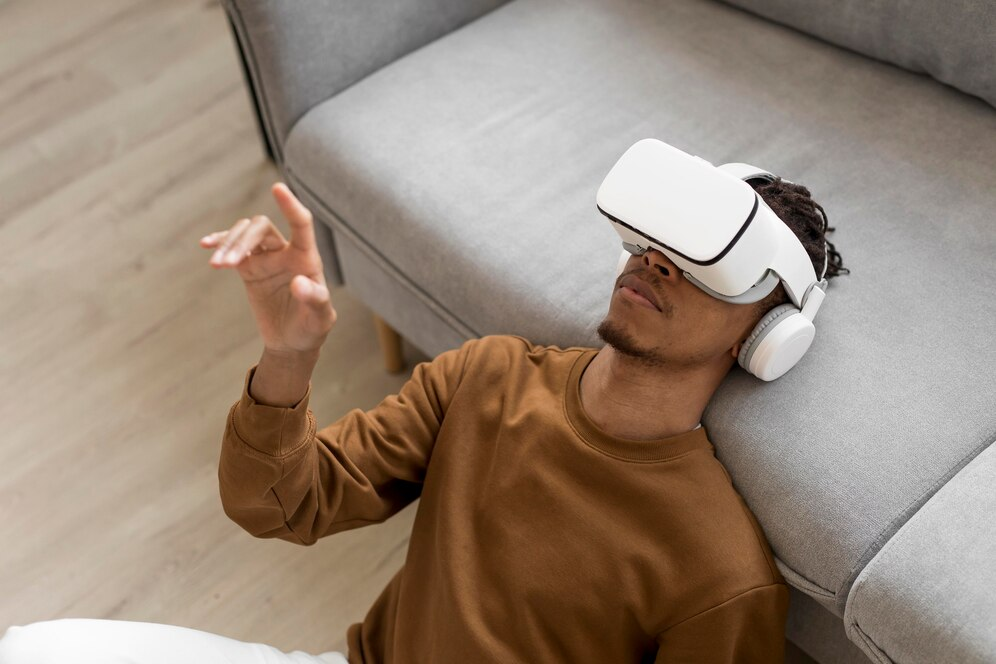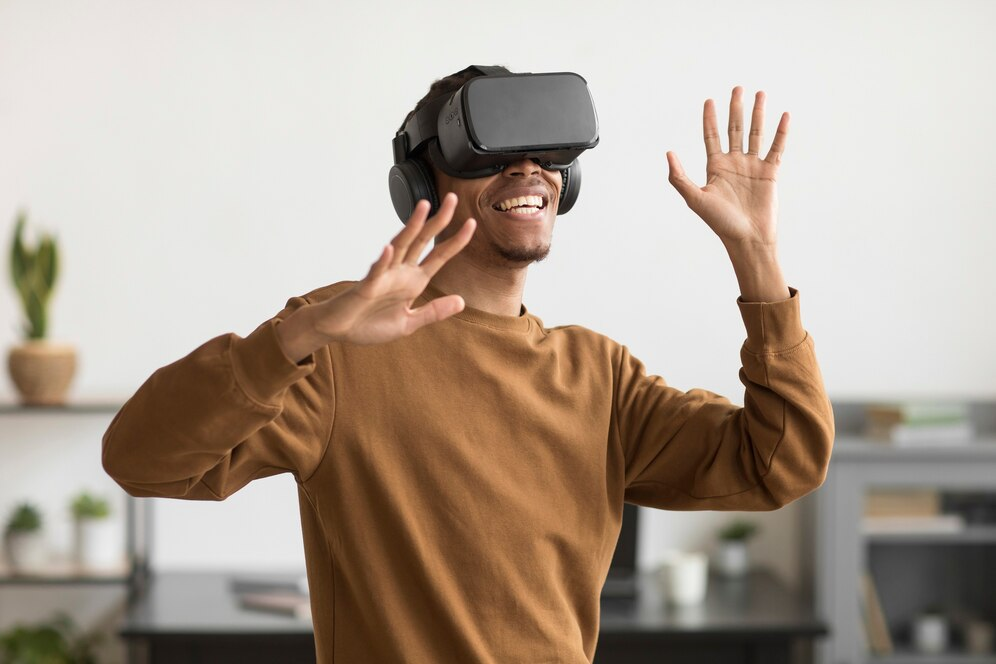Is a VR Headset Worth It? Exploring Virtual Reality’s Value

Virtual reality has been taking off in popularity in the past few years, but to some, this technology may still seem like nothing more than a gimmick. Is VR a new technology that’s likely to be around for years to come, or is it merely a passing fad? While it may be too early to say definitively one way or the other, there are plenty of signs that virtual reality is here to stay and well worth your investment.
Are Virtual Reality Headsets Worth It?
For many people, investing in virtual reality headsets is totally worth it. It’s easy to write off VR headsets as nothing more than video game accessories, but this couldn’t be further from the truth: In fact, VR headsets have the potential to improve nearly everyone’s life. Already, virtual reality is being used to improve military training, hospital patient care, and education at schools and colleges across the country. VR headsets also open up travel opportunities, allowing people to virtually see and experience places that they might never be able to get to in person. From natural formations like the Grand Canyon to famous museums, you may be surprised just how many options are open to you. You can also use a VR headset to get work done in virtual workspaces or watch movies on an enormous screen right in front of you, either alone or with friends. There’s truly so much you can do with a VR headset that it’s hard to imagine anyone not having a positive experience with one.
Of course, for all of their pros, VR headsets do have one con: their prices. VR headsets come at a range of price points, though, so there’s sure to be one that makes sense for you, whether you want to make a big investment or start small. You can buy a top-of-the-line piece of equipment that requires an investment of $1,000 or more, including the cost of the high-end gaming PC, or you can choose a more affordable headset like the Oculus Quest 2, which costs just $299. Either way, you’re sure to find something that appeals to you in the virtual world that makes your investment worthwhile.
Are VR Games Worth It?
For those who enjoy video games of any kind, VR games are well worth the investment. There’s something for everyone, from rhythm games to first-person shooters to RPGs and puzzle games, and all of these games are designed to be completely immersive, making you feel like you’re really there in the simulated worlds they’ve created. Games like Beat Saber have shown us just how much more fun a rhythm game can be when you’re actually using your whole body. And games like Skyrim VR and Resident Evil 4 have showcased that even traditional gaming experiences can be made better with VR. Best of all, you’ll find that the cost of many VR games is quite reasonable. Some of them are even free!
If you consider yourself a gamer, the answer to whether or not VR is worth it is an emphatic “yes.”
Virtual reality (VR) has been a buzzword in tech circles for a while, promising immersive experiences ranging from gaming to education and beyond. As VR technology advances, potential users commonly wonder, “Is a VR headset worth it?” In this post, we’ll look at different features of VR technology to help you decide if VR headsets are worth the investment.
What is Virtual Reality?

By utilizing computer technology, virtual reality (VR) creates a computer-generated environment that people may interact with in a manner that appears to be real. Using virtual reality (VR), the user is immersed in an experience, as opposed to conventional user interfaces. Through the use of numerous sensory simulations, including vision, hearing, and touch, this technology constructs an explorable virtual environment. A virtual reality headset is typically necessary to enter this realm, which begs the question: are VRs worth it?
The Cost of VR Headsets
The price of VR headsets varies significantly depending on the brand, technology, and specifications. Here’s a quick breakdown of VR headset costs:
Entry-level VR Headsets
Entry-level VR headsets serve as an accessible entry point for individuals keen on delving into the world of virtual reality without committing to a hefty investment. These headsets are characterized by their simplicity and affordability, making them suitable for casual users or beginners exploring the immersive possibilities of VR technology. The cost range for entry-level VR headsets typically spans from $150 to $300, offering an attractive option for those on a budget.
- Oculus Go: Priced around $200, the Oculus Go stands out as a popular choice among entry-level VR enthusiasts. This standalone headset eliminates the need for additional hardware, providing users with a wireless VR experience right out of the box. With built-in speakers and a diverse selection of available apps and games, the Oculus Go offers an accessible introduction to virtual reality entertainment.
- Samsung Gear VR: Another notable contender in the entry-level category is the Samsung Gear VR, which shares a similar price range to the Oculus Go. Designed to work in tandem with compatible Samsung smartphones, this headset delivers an immersive VR experience through the use of the smartphone’s display and processing power. With access to a vast library of VR content, the Samsung Gear VR offers users an affordable gateway into the realm of virtual reality.
Mid-range VR Headsets
Mid-range VR headsets bridge the gap between entry-level models and high-end offerings, providing users with enhanced features and performance without the premium price tag. These headsets cater to individuals seeking a more immersive VR experience, offering improvements in display resolution, tracking accuracy, and overall comfort. Priced between $300 and $500, mid-range VR headsets strike a balance between affordability and functionality.
- Oculus Quest 2: Positioned at around $400, the Oculus Quest 2 is a standout choice in the mid-range VR market. This versatile headset combines wireless VR gaming with a high-resolution display, built-in speakers, and intuitive hand tracking capabilities. With its all-in-one design, the Oculus Quest 2 appeals to users looking for a convenient and immersive VR solution without the need for additional hardware or cables.
- Sony PlayStation VR: Another prominent contender in the mid-range category is the Sony PlayStation VR, priced at approximately $300. Designed specifically for use with the PlayStation 4 console, this headset offers seamless integration with a vast library of VR games and experiences. With its comfortable design and responsive tracking, the Sony PlayStation VR provides users with an immersive gaming experience that leverages the power of the PlayStation platform.
High-end VR Headsets
High-end VR headsets represent the pinnacle of virtual reality technology, catering to enthusiasts and professionals who demand the utmost in performance and immersion. These headsets boast cutting-edge features such as ultra-high-resolution displays, advanced tracking systems, and compatibility with a wide range of accessories. While the price for high-end VR headsets can exceed $1000, the unparalleled experience they offer justifies the investment for discerning users.
- Valve Index: Priced at approximately $1000, the Valve Index stands out as a premier choice among high-end VR enthusiasts. This flagship headset delivers high-fidelity VR experiences with features such as full-body tracking, precise hand controllers, and a wide field of view. With its top-of-the-line specifications and robust tracking technology, the Valve Index sets the standard for immersive VR gameplay and simulation.
- HTC Vive Pro: Another notable contender in the high-end segment is the HTC Vive Pro, which shares a similar price point to the Valve Index. Boasting a high-resolution display, accurate tracking, and compatibility with a wide range of VR accessories, the HTC Vive Pro offers users a premium VR experience tailored to their specific needs. Whether for gaming, professional applications, or immersive simulations, the HTC Vive Pro delivers unparalleled performance and immersion for discerning users.
The VR Experience

One of the most significant selling points for VR headsets is the unique gaming and entertainment experience they offer. VR provides an immersive form of gameplay and interaction that is not achievable with traditional gaming systems. Here are a few highlights of what VR has to offer:
Immersive Gaming
VR gaming takes immersion to a whole new level by allowing players to step inside their favorite games and interact with the virtual environment in a fully immersive 360-degree world. Unlike traditional gaming, where players are limited to controlling characters from a distance, VR gaming puts them directly into the action, allowing for a more engaging and lifelike experience.
- Realistic Environments: VR games often feature highly detailed and realistic environments that make players feel like they are truly inhabiting another world. Whether exploring alien planets, navigating haunted houses, or battling enemies in futuristic landscapes, VR gaming offers an unparalleled sense of presence and immersion.
- Interactive Gameplay: In VR, players can interact with objects and characters in the virtual world using motion controllers or other input devices, adding a new layer of realism and interactivity to gameplay. Whether swinging a virtual sword, shooting enemies with a virtual gun, or solving puzzles with hand gestures, VR gaming offers endless possibilities for interactive gameplay experiences.
Virtual Tours
VR technology also enables users to embark on virtual tours and explore destinations around the world from the comfort of their own home. Through immersive 360-degree videos and virtual reality applications, users can visit famous landmarks, historical sites, and natural wonders without ever having to leave their living room.
- Educational Opportunities: Virtual tours can be a valuable educational tool, allowing students to learn about different cultures, historical events, and scientific phenomena in an interactive and engaging way. By immersing themselves in virtual environments, students can gain a deeper understanding of the subject matter and develop important critical thinking and problem-solving skills.
- Accessible Travel: For individuals who may have physical limitations or financial constraints that prevent them from traveling, VR tours offer a convenient and accessible alternative. Whether exploring the streets of Paris, trekking through the Amazon rainforest, or diving into the depths of the ocean, VR tours allow users to experience the world in ways that would otherwise be impossible.
Educational Applications
Beyond gaming and virtual tours, VR technology has a wide range of educational applications that can be used to enhance learning and training in various fields. From healthcare and military training to vocational skills development and classroom education, VR provides an immersive and interactive learning environment that simulates real-world scenarios.
- Hands-on Training: VR simulations allow users to practice hands-on skills in a safe and controlled environment, making it ideal for training purposes in industries such as healthcare, aviation, and manufacturing. Whether performing surgery, flying a plane, or operating heavy machinery, VR training simulations provide valuable hands-on experience without the risk of real-world consequences.
- Experiential Learning: In educational settings, VR can be used to create immersive learning experiences that engage students and encourage active participation. Whether exploring historical events, conducting science experiments, or learning foreign languages, VR simulations can bring learning to life in ways that traditional textbooks and lectures cannot.
VR in Professional Settings
Beyond gaming and entertainment, VR technology is also making strides in professional environments, which might make one consider if a VR headset is worth it for professional use. Here are some applications:
Medical Field
In the medical field, VR is proving to be a valuable tool for training and surgical planning, offering immersive simulations that can enhance the skills of healthcare professionals and improve patient outcomes.
- Surgical Simulation: Surgeons use VR to simulate complex surgical procedures before performing them on actual patients. By immersing themselves in virtual operating rooms, surgeons can practice techniques, refine their skills, and anticipate potential challenges, ultimately leading to safer and more successful surgeries.
- Patient Education: VR can also be used to educate patients about medical conditions and treatment options in a more engaging and interactive way. By visualizing anatomical structures and medical procedures in virtual reality, patients can gain a better understanding of their healthcare journey and make more informed decisions about their treatment.
Real Estate
In the real estate industry, VR technology is transforming the way properties are marketed and showcased to potential buyers, offering immersive virtual tours that allow users to explore homes remotely.
- Virtual Property Tours: Real estate agents use VR to create virtual tours of properties, giving potential buyers the ability to virtually walk through homes and explore every room and detail in 360 degrees. This immersive experience allows buyers to get a realistic sense of the property’s layout, design, and features without the need for physical visits.
- Remote Collaboration: VR also enables real estate professionals to collaborate with clients and colleagues remotely, facilitating virtual meetings and property viewings from anywhere in the world. This not only saves time and travel costs but also expands the reach of real estate marketing efforts to a global audience.
Education
In the field of education, VR is revolutionizing the way students learn by providing immersive and interactive experiences that go beyond the limitations of traditional classroom settings.
- Virtual Field Trips: Teachers use VR to take students on virtual field trips to historical landmarks, natural wonders, and other educational destinations around the world. By experiencing these places in virtual reality, students can gain a deeper understanding of the subject matter and engage with it in a more meaningful way.
- Interactive Learning: VR allows educators to create interactive learning experiences that cater to different learning styles and abilities. Whether exploring the human body in 3D, conducting virtual science experiments, or practicing language skills in immersive environments, VR provides endless opportunities for experiential learning and engagement.
Pros and Cons of Owning a VR Headset

To further address the question “Is a VR headset worth it?”, let’s consider the advantages and disadvantages.
Pros
Investing in a VR headset comes with an array of benefits that cater to various interests and preferences, making it an appealing option for individuals seeking immersive digital experiences.
- Unique Experiences: One of the most significant advantages of VR technology is its ability to provide users with unique and unparalleled experiences. VR allows users to step into virtual worlds and interact with them in ways that were previously unimaginable. Whether exploring fantastical landscapes, piloting spacecraft, or solving puzzles in immersive environments, VR offers a level of immersion that traditional media simply cannot match.
- Increasing Content Availability: As the popularity of VR continues to grow, so too does the availability of content for VR platforms. Developers are constantly creating new and innovative experiences for VR users, ranging from captivating games and simulations to educational tools and virtual tours. With a diverse and expanding library of content, VR headset owners can always find something new and exciting to explore.
- Social Interaction: VR provides a unique platform for social interaction and communication, allowing users to connect and engage with others in virtual spaces. Whether playing multiplayer games with friends, attending virtual events and concerts, or collaborating on projects in virtual environments, VR enables users to interact with others in a more immersive and engaging way. This can be particularly valuable for individuals who are unable to meet in person due to geographical distance or other constraints.
Cons
While owning a VR headset offers numerous advantages, there are also several considerations and potential drawbacks that users should be aware of before making a purchase.
- Cost: One of the primary concerns for prospective VR headset owners is the cost associated with purchasing the device itself, as well as any necessary accessories and software. While entry-level VR headsets may be relatively affordable, higher-end models with advanced features and capabilities can come with a hefty price tag. Additionally, the cost of building or upgrading a computer system to meet the requirements of VR can further increase the total cost of ownership.
- Space Requirements: Using VR safely and effectively requires a significant amount of clear space, as users need room to move around and interact with virtual environments without risk of injury or damage to surrounding objects. Setting up a dedicated VR play area with adequate space can be challenging for individuals living in small apartments or confined spaces, limiting the accessibility of VR experiences.
- Motion Sickness: Motion sickness is a common issue that some users may experience when using VR headsets, especially during fast-paced or highly immersive experiences. The sensation of virtual motion can sometimes conflict with the user’s physical senses, leading to discomfort, nausea, and dizziness. While motion sickness can often be mitigated through gradual exposure and adjustments to settings, it remains a potential concern for some users.
Conclusion
Is a VR headset worth it? The answer largely depends on your personal or professional interests and needs. If the unique experiences offered by VR technology excite you, investing in a VR headset could very well be worth it. As VR content continues to grow and expand into different fields, the value proposition of VR headsets becomes even more compelling. Whether for work, education, or entertainment, VR has the potential to significantly enhance how we interact with digital content.
FAQ
It depends on your interest in immersive gaming. If you enjoy being inside the game environment, it might be a worthwhile investment.
Absolutely. VR can transform learning experiences by providing practical simulations and interactive environments.
With proper care, a VR headset can last several years. Technological obsolescence is a bigger issue, as newer, more advanced models are frequently released.
For high-end VR headsets, yes. Mid-range and entry-level models, however, often have lower requirements or are completely standalone.